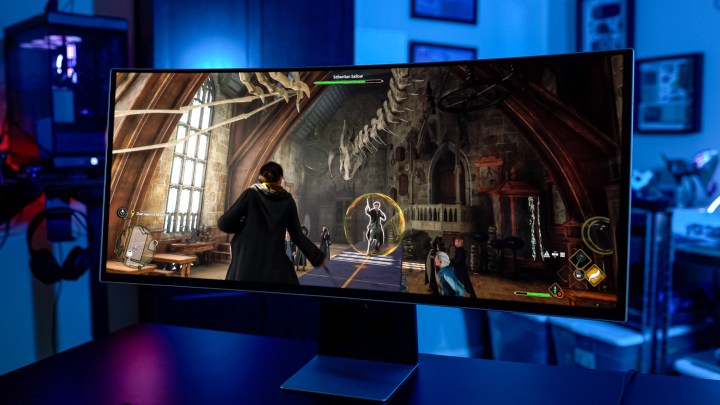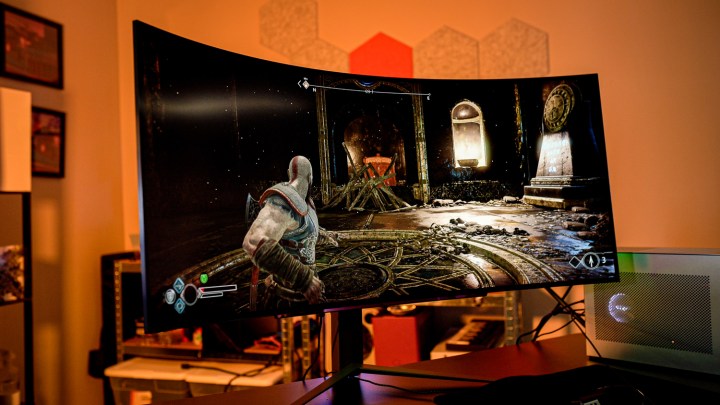It’s been hard to avoid OLED among the best gaming monitors this year. What started as a trickle of OLED late last year turned into a flood of OLED this year, with every major monitor brand jumping in on the OLED hype. And now that we’re closing out the year, I can see why.
OLED has made playing PC games so much better this year. We finally have great HDR on PC, super low response times, and panel tech, making the monstrous monitors we’ve grown to love much more practical.
HDR that works

Mid-way through last year, I wrote about the sad, misleading state of HDR for PC gaming. We’ve had HDR on Windows for years, but the state of the tech, especially in games, has been laughable at best. There are still some bugs with
We saw the first OLED gaming monitors last year, but there was an explosion of them this year. We finally saw standard 27-inch displays like the LG UltraGear OLED 27, along with evolved forms of exotic form factors like the Samsung Odyssey OLED G8.
OLED is the perfect answer to the HDR problem in PC gaming. OLED uses individual self-emitting diodes, so each pixel can control its own brightness, including turning completely off. It allows OLED monitors to achieve a theoretically infinite contrast ratio — anything compared to pure black is infinite contrast.

That’s what gaming monitors have lacked for so long, and that contrast is exactly what makes HDR tick. With LCD
Outside of the brightness battle, OLED displays also have a wide color gamut. That’s essential for HDR, and it’s something you don’t need to think about on an OLED screen. LCD panels, even color-accurate ones, may not have an extended color range, adding disappointing color reproduction and tone mapping on top of poor contrast.
Super speed

The unsung advantage of OLED is that it’s fast — really fast. That comes back to the organic material OLED uses. Each diode controls its own light, so it can transition from being on to off almost instantly and transition between colors much faster than LCD displays. That makes OLED feel much more responsive in games.
More importantly, it makes the image much clearer. We’re in an era of very high refresh rates on gaming monitors, and OLED can handle the heat as the refresh rate increases. Displays like the Alienware 500Hz gaming monitor challenge the typical response time of LCDs, and even OLED
That’s due to how response time interacts with refresh rate. Your monitor refreshes on a fixed cycle — if it’s 60Hz, you’ll get a new image every 16.6ms. At 240Hz, it’s every 4.2ms. Your response time needs to be less than the time it takes to refresh the screen. If it’s not, you’ll see a smear on your screen, with the monitor refreshing while some pixels are transitioning from one color to a different one.
As refresh rates climb, faster response times become more important.
Most gaming monitors advertise a response time of 1ms, but that number isn’t exactly accurate. Response times, particularly when transitioning between colors, are much higher. It’s hard to nail down one single response time number, as different colors and brightness levels can vastly impact how fast the response time really is.
Regardless, faster response times become more important as the refresh rate climbs. And OLED, even if it shows smearing in some cases, is much faster than LCD. You’re not only getting great responsiveness when playing games due to a high refresh rate but also great motion clarity with the response time, minimizing blurring and smearing in a way LCDs just can’t manage.
Taking different forms

HDR and fast response times are one thing, but OLED is a lot more practical for PC gaming, too. OLED panels are super thin. They don’t need a backlight, allowing the actual panel to be much smaller than a traditional LCD arrangement.
That’s a huge advantage, which became clear while writing my Samsung Odyssey OLED G9 review. That monitor measures 49 inches diagonally and comes with a 32:9 aspect ratio. It’s huge. However, the OLED version is much thinner than its predecessor, with a thin metal back and a subtle curve. The previous version had a chunky plastic back and an aggressive 1000R curve, making it feel even bigger than it already was.

OLED has also offered brighter, larger, faster screens to handhelds, particularly in the Steam Deck. The Steam Deck OLED is a massive upgrade over the original, and that’s due in no small part to the screen. It makes HDR possible in a handheld form factor for the first time, with higher brightness and better colors.
We’re only starting to see how OLED can enhance the form factor of PC gaming. Thinner monitors are one thing, but OLED really shines when it’s applied in places like the Steam Deck OLED or Odyssey OLED G9.
OLED in 2024

For PC gaming, OLED is just getting started. We already know about some exciting gaming monitors coming out next year, including LG’s 480Hz OLED gaming display, and there will likely be many more.
With refresh rates climbing, new form factors for PC gaming, and better HDR than we’ve ever seen on PC, it’s an exciting time to be a PC gamer. If there’s anything I’m looking forward to in OLED displays next year, it’s newer models pushing down the price of displays we already have, making it so everyone can enjoy what the display tech has to offer.
Editors' Recommendations
- Nvidia might power your next handheld gaming PC
- I want to love Asus’ gaming earbuds, but there are problems
- This simple app was a surprising upgrade to my gaming PC
- The simple reasons your PC games don’t play as well as they should
- It’s time to stop settling for a noisy gaming PC




